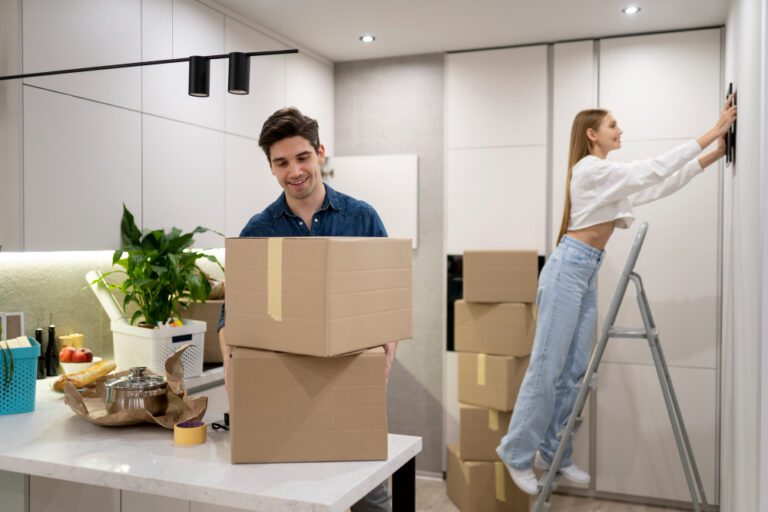Welcome to our comprehensive guide on how to successfully pack and move your cherished artwork in Vero Beach. This post is dedicated to those who understand that artwork is more than just an aesthetic addition to their homes or offices; it holds significant sentimental value and, in many cases, substantial monetary worth as well.
Each piece tells a story, carries a memory, or symbolizes a moment in time, and it’s our responsibility to protect these irreplaceable treasures during the often daunting process of moving.
Whether you’re a collector of fine art, a gallery owner, or someone who simply appreciates the beauty of an art piece on your wall, this guide is designed to assist you. Our aim is to provide you with the necessary insights, comprehensive steps, and expert tips to ensure your precious pieces of art are safely transported to their new location.
With our experienced professionals, state-of-the-art packing supplies, and custom crating solutions, we at Friends Moving are committed to ensuring that your artwork is meticulously handled and securely moved, thereby preserving its integrity during the relocation process.
The Challenges of Moving Artwork
Moving artworks poses unique challenges due to their delicate nature and high value. Many things can go wrong if the artwork isn’t properly handled during the packing and moving process. It’s important to be aware of these potential pitfalls so that you can avoid them and ensure the safe transportation of your artwork.
- Delicate Materials: Many artworks are created using delicate materials that can be easily damaged by bumps, drops, or even changes in temperature and humidity. These materials include canvas, paper, ceramic, glass, and various types of metal.
- Valuable and Irreplaceable: Artworks often carry a high monetary value, but beyond that, they can hold a significant sentimental or historical value that makes them irreplaceable. Damage to these items can be a significant financial and emotional loss.
- Complex Shapes and Sizes: Artworks come in a variety of shapes and sizes. Some pieces can be large, heavy, and awkward to handle, increasing the risk of damage during the move.
- Sensitivity to Climate Conditions: Certain types of artwork, such as oil paintings and watercolors, are highly sensitive to changes in temperature and humidity. Without climate-controlled transportation and storage, these pieces can be seriously damaged.
Read on to find out how to prepare your artwork for a move and how to choose the right moving company that can handle these valuable and delicate items.
Read More: The Cost of Moving in Vero Beach
Preparations Before the Move
Before you even think about wrapping or boxing, your first step in preparing for the move should be a thorough assessment and cataloging of your art collection. Create a detailed inventory of your artwork including information such as the artist’s name, dimensions, medium, condition, and estimated value.
Photograph each piece from different angles to have a clear visual record. This step not only helps you to keep track of your items but also serves as an invaluable resource if something gets lost or damaged during the move.
The importance of securing proper insurance for your artwork cannot be overstated. Accidents can happen, no matter how careful you are or how reputable your moving company is. Therefore, it’s essential to have your collection adequately insured based on its overall value.
If you’re unsure about the value of your art, consider having it appraised by a professional. If you own high-value or particularly fragile items, consult with an art conservator. These professionals can provide advice on how best to handle, pack, and transport your artwork, ensuring that it arrives at its new home in the same condition it left the old one. This may involve a cost, but it’s a worthwhile investment to safeguard your precious artwork.
Required Packing Materials for Artwork
Having the right materials at hand is vital when packing artwork for a move. Each piece is unique and may require different packing solutions.
Below, we’ll outline some essential supplies you’ll need, plus a few specialized materials for various types of artwork. We’ll also guide you on where to find these supplies in Vero Beach.
- Bubble Wrap: This is essential for providing a cushion around your artwork to protect it from shocks and vibrations during the move.
- Packing Tape: Heavy-duty packing tape is crucial for securing bubble wrap and sealing boxes.
- Cardboard Corners: These can be placed on the corners of framed artworks to provide extra protection.
- Art Boxes: These are specially designed boxes for artwork. They come in a range of sizes and offer more protection than standard boxes.
- Packing Paper or Blank Newsprint: Use this to wrap small items and to fill gaps in boxes to prevent movement during the move.
- Foam Boards or Sheets: For extra delicate or valuable items, foam boards provide a rigid layer of protection.
- Glassine Paper: A type of smooth, acid-free paper that’s ideal for wrapping artwork. It’s resistant to air, water, and grease.
- Acid-Free Archival Tissue: This is crucial for protecting artwork, especially those sensitive to acid degradation.
Step-by-Step Guide to Packing Artwork
Successfully packing artwork for a move requires a meticulous approach and careful handling. Different types of artwork will necessitate varied packing techniques to ensure they reach their destination safely.
Moreover, correctly labeling your packed art and considering the needs of large or heavy pieces are essential aspects of the process. Let’s delve into a comprehensive step-by-step guide for packing your artwork:
1. Paintings
- Begin by covering the painting with acid-free tissue paper to prevent direct contact with other materials that might cause damage.
- Use cardboard corners for framed pieces to protect the edges of the frame.
- Wrap the piece in bubble wrap, ensuring all areas are covered, and secure it with packing tape.
- If the piece is small enough, place it in a box with additional cushioning materials. For larger pieces, consider using a custom-made crate or a flat-fitted picture box.
2. Sculptures
- Sculptures often require a customized approach due to their varied shapes and sizes. Start by wrapping the sculpture in acid-free tissue paper.
- Follow up with bubble wrap, ensuring all surfaces are covered, and secure it with packing tape.
- Place the wrapped sculpture in a box filled with packing peanuts or crumpled packing paper for added protection.
- For large or delicate sculptures, consider using a custom-built wooden crate.
3. Ceramics and Glass Art
- Start by filling the inside (if hollow) with bubble wrap or packing paper to provide internal support.
- Wrap the item in acid-free tissue paper, followed by bubble wrap, and secure it with packing tape.
- Place the item upright in a box with enough packing peanuts or bubble wrap at the bottom, sides, and top.
- For particularly fragile pieces, consider using a double-boxing method for extra security.
4. Proper Labeling
- Clearly mark each packed piece of artwork with labels indicating ‘FRAGILE’ and ‘HANDLE WITH CARE’ to ensure the movers are aware of the care needed.
- Mark the top of the boxes with ‘THIS SIDE UP’ labels to prevent them from being turned upside down.
- Label the boxes with a general description of their contents for easy identification. For privacy and security, avoid writing down specific details of valuable items.
- Number each box if there are multiple ones, for example, ‘Box 1 of 3’, ‘Box 2 of 3’, and ‘Box 3 of 3’. This can help keep track of all items during the move.
5. Considerations for Large and Heavy Artworks
- Custom-built crates may be necessary for exceptionally large or heavy pieces. These offer better protection and are easier to handle during the move.
- Using a professional art moving service is highly recommended for such pieces to avoid personal injury or damage to the artwork.
- Check the dimensions of doorways, hallways, and stairwells before the move. Large pieces might require special equipment or additional manpower to move.
- Consider the weight capacity of the moving truck’s ramp and lift, and make sure it can accommodate the heavy artwork.
- Ensure that your destination also has the appropriate space and access points to accommodate the size and weight of your artwork.
Read More: Affordable moving services in Vero Beach
Friends Moving: The Right Moving Company for Artwork in Vero Beach
When moving valuable artwork, such as items from auction houses or even delicate items like golf clubs, choosing the right experienced professionals from a trusted moving company is crucial. A competent art moving company should have extensive experience in handling artwork, trained staff, proper equipment, and insurance coverage.
They should be able to offer professional packing services, including custom crating and specialized art packing services, access to high-quality packing materials, and a track record of successful artwork relocations. A consultation or pre-move survey to understand the scope and specifics of your artwork relocation project is also an indicator of a reputable company.
Our team of packing experts is professionally trained in art packing, handling, and providing custom crating for various types of fine art, including paintings, sculptures, ceramics, and more. Furthermore, we offer a range of art moving services that can be customized to fit your specific needs.
Our experience as packing and shipping professionals, coupled with our commitment to customer satisfaction, has earned our business positive testimonials from numerous clients. With Friends Moving, you can rest assured that your valuable pieces are in safe and capable hands.
At Friends Moving, we offer a comprehensive range of services, including residential moving, senior moving, various storage options, business moving, family relocation, nationwide moving,full-service moving and packing, as well as specialty moving for unique needs.
The Process of Moving the Artwork
Moving artwork involves more than simply boxing up items and transporting them from point A to point B. It demands a high level of care, expertise, and precision at every step of the way.
From professional handling to specialized transit measures and careful unpacking and setting up at the new location, each step has its own challenges and requirements. Here’s a detailed look at the process:
1. Assessment and Handling
The first step in the art moving process is an assessment of the pieces to be moved. This involves taking into account the size, weight, material, and value of the artwork. Once assessed, the handling process begins. With Friends Moving, you can trust our professionally trained team to handle your artwork with the utmost care, using techniques perfected over many years to ensure the safety of each piece during transport.
2. Packing
Packing is arguably one of the most crucial steps in moving artwork. It requires specialized packing materials and an understanding of how to protect different types of art. The packaging process is tailored to each artwork’s unique needs, taking into account the item’s fragility and providing custom crating when necessary, with acid-free tissue paper, bubble wrap, and custom-built crates used to offer maximum protection.
3. Loading and Transit
Once the artworks are securely packed, they are carefully loaded onto our specialized moving trucks. These vehicles are equipped with features like climate control to maintain an optimal environment for the artwork throughout the journey, especially for long-distance moves. The loading process is methodically done to ensure each piece is stable and secure during transit.
4. Unloading and Unpacking
Upon arrival at the new location, the unloading process begins. Each box containing the fine art is carefully removed from the truck and transported to its designated location in the new premises. The unpacking process is handled with as much care as the packing process, ensuring that each artwork remains in pristine condition.
5. Setup
The final step in the art moving process involves setting up the artwork in its new home. This could involve hanging paintings, positioning sculptures, or arranging other pieces of artwork in their new locations. At Friends Moving, our team can assist with the setup process, placing each artwork according to your preferences and ensuring they’re secure.
Conclusion
Moving artwork requires a significant amount of care and expertise to ensure your valuable pieces reach their new destination unscathed. As we’ve outlined in this guide, the process involves careful preparation, specialized packing, strategic loading, and delicate unpacking. Selecting a reliable and experienced moving company, like Friends Moving, is critical to ensuring the safety and security of your artwork.
We encourage you to prepare thoroughly, invest in high-quality packing materials, and trust professionals with experience in art moving. If you are planning to move artwork in Vero Beach, don’t hesitate to contact Friends Moving. We promise a service tailored to your needs and dedicated to the safety of your artwork.
FAQs
While it’s not a requirement, getting an appraisal can be beneficial, particularly for valuable pieces. It helps establish the value of your artwork, which is useful for insurance purposes during the move.
Absolutely. Friends Moving offers professional packing services tailored to different types of artwork. Our team is trained in packing techniques that ensure the safety of your art during transit.
At Friends Moving, we have solutions for such situations. We can use specialized equipment or techniques to safely move large pieces out of your home and into our moving truck.
For long-distance moves, we use climate-controlled moving trucks to ensure the environment is stable throughout the journey. We also secure each piece in the truck to prevent movement during transit.
Yes, we can help you set up your artwork in your new location as part of our comprehensive moving services. We’ll ensure each piece is safely and securely placed according to your preferences.






